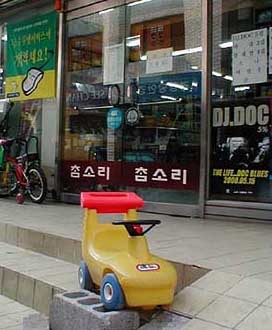

|
I spotted this Little Tikes ride-'em car parked outside a Kangnung (Gangneung) shop one day in May, 2000.
I would have loved to have asked the shopkeeper if this was his daily driver. It would've
just confused him, though. Such jokes don't usually translate very well. Little Tikes is one of the few companies still making toys in the US, which makes this a foreign car. At the time, that was unusual -- I mean the fact that it was a foreign car in Korea. Back then, Koreans who bought foreign vehicles could expect to be harassed with tax audits. The import duties and taxes on foreign cars were sky-high, so the Korean government assumed that if you could afford an import, you were probably filthy rich, and they were darn well going to make sure you paid your share (at least) of taxes. Those days are over. Korea has lifted most of its trade barriers. It's been ongoing, but the big change came in 2011. That's when Korea reached an agreement with the EU. It was mostly pushed by Europe's automakers, in a panic over increasing Korean imports there. The irony is that while the Korean boom didn't really materialize in Europe the way they expected, the agreement greatly increased European imports to Korea. In 2004, 3% of Korea's vehicle sales were imports. In 2014, that had soared to 14%. The vast majority -- 71% -- were from Germany. Today BMW and Mercedes cars and SUVs are still marks of status for big-won Koreans, but no more do they have to worry about being hassled by the tax man - or by their fellow Koreans, which also used to happen. But Japanese vehicles? Not yet. They haven't caught on in nearly as big a way. Maybe they never will, thanks to the long-standing (and understandable) grudge that Korea harbors against Japan for their occupation and World War II exploitation. You may never see Toyotas and Hondas in Korea the way you see them in the States and Europe - though they're not entirely absent.
|